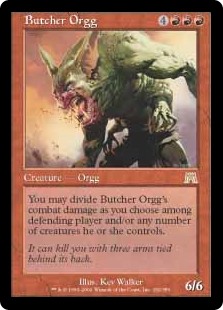“Send in Bob from Accounting.”
Magic: the Gathering is one of the most successful tabletop games ever, not only in terms of its longevity but also its profitability. Although it must forever be content with its own ‘innovate or die’ model and a corporate behemoth parent company in Hasbro that doesn’t afford it a ton of room for error, as a product Magic nevertheless has proven to be one of the highest grossing games in history. And like most games, it has largely done this without the advent of traditional marketing.
This isn’t to say that Magic doesn’t advertise. In fact, it actually does more of this than most other card and board games in the hobby. Yet most of that advertisement is targeted towards the existing gamer base or in avenues that are likely to entice potential new players – game store displays, convention events, online game platforms, social media tie-ins, and so on. It knows what its core demographics are and takes strides to broaden its appeal in those spaces. The best ROI and all that. Hasbro also has larger ambitions for its cash cow IP, including orchestrating a strong push into esports territory and the use of its material for part of proposed water park full of Hasbro game IPs.
Despite it being one of the few games with a dedicated marketing budget, however, you don’t really see Magic advertised in more mass media or broad-based avenues such as mainstream magazines or television.
But that doesn’t mean they haven’t tried.
Way, way back in 1998, Magic actually did experiment with a series of TV ads in order to sell their product (specifically, the Portal set). Just a few years outside of its initial release (and ironically prior to its acquisition by Hasbro), Wizards of the Coast was trying to find ways to broaden its reach for new players. One of the ways they attempted this was with a limited TV commercial push on MTV and some of the more popular shows at the time.
The company created a few different ads to that end, but Bob from Accounting was by far the most memorable of the bunch. In it, you are treated to the inner workings of a fictional Magic testing facility, pitting a Raging Goblin against an Orgg – a large, very strong, and very dumb hybrid between a orc and an ogre. The joke is that the Goblin is out sick, so they pit the Orgg against Bob from Accounting. And the rest is Magic TV history.
It was also the highest point of pride for an Orgg before or since. Because while the TV ad is memorable in its own right, Orggs themselves…not so much.
The truth is that while they are a uniquely Magic creature, of all the creatures to choose from Orgg was an odd choice. Because at the time of the ad campaign, only the original Orgg from Fallen Empires was in print, and it wasn’t a beloved card to use even back then.
More to the point, the game has only gone on to make three more Orgg cards since then for a variety of reasons, including their Dominaria-centric existence. And of the four Orgg cards, the first three are utterly forgettable.
The final Orgg, on the other hand, is what brings us here this week.
Today we have: Butcher Orgg

Name: Butcher Orgg
Edition: Onslaught
Rarity: Rare
Focus: Damage Dealing
Highlights: Someone must have been really keen on the Orgg redemption tour, or at least really felt that it needed a card to reflect those earlier TV spots. Either way, that’s what we got in 2002’s Butcher Orgg, a surprisingly underrated heavy hitter from Onslaught that gives you some damage-dealing combat options.
Reflecting an Orgg’s not-so-intellectual nature, Butcher Orgg is a pretty straightforward creature with some useful tactical implications. For seven mana you get a 6/6 creature, which is around par for creature costs (and certainly was in 2002).
If that were all you were getting, however, it would be an incredibly hard sell for most deck builds – even if that, coincidentally enough, is the cost of a Trained Orgg.
Enter its combat ability.
Butcher Orgg’s unique ability states that when it deals combat damage, you are able to divide up its 6+ damage however you want among the player and any creatures the defender controls – not just those blocking or involved in combat. This makes for an even more versatile iteration of “Super Trample”, wherein you can choose to do damage to the player even if they are blocked. Butcher Orgg still provides that option – a rarity outside of Green in and of itself – while going the additional step of letting you dole out damage to creatures sitting on their side of the battlefield.
This can be an incredibly useful creature-centric way of dealing with smaller creatures that they may not want to block with and / or those that can be otherwise difficult to kill thanks to Shroud or Hexproof. This latter part is particularly noteworthy in Commander, as an often overlooked aspect of Butcher Orgg’s damage division ability is the fact that it doesn’t target the creatures it’s damaging. Just pure, unrestricted Orgg rampaging.
As far as big stompy Red creatures go, Butcher Orgg is better and more versatile than it seems at first glance, and its only real drawback is its triple Red mana cost, which makes it hard to splash into decks of more than two colors. That, and it often isn’t deemed super flashy. But that’s not really Orgg’s style anyhow. It doesn’t really do finesse so much as attacking with wild abandon.
Just ask Bob from Accounting.
Keep an eye out for us to be regularly featuring other more accessible-but-worth-it Commander cards going forward. In the meantime, we’ll keep the light on for you.
![]()
You can discuss this article over on our social media!
